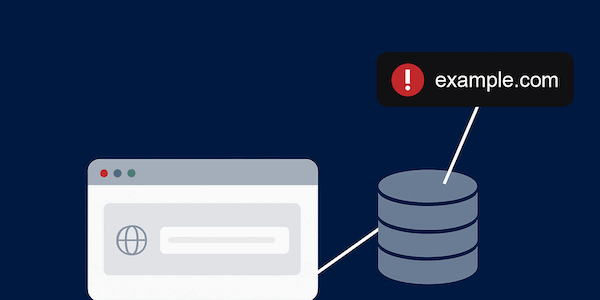A domain name may look harmless — just an address that points users to your website. But behind every domain lies a treasure trove of information freely available to the public. From DNS records and certificates to historical data and internet scanners, an attacker can piece together your infrastructure like a digital jigsaw puzzle.
“Security through obscurity” — the idea that hiding something makes it safe — might sound comforting, but it doesn’t work in today’s interconnected world. This article explains just how much public information can be revealed from a single domain name and what you can do to minimise exposure.
The Public Footprints of a Domain
Every domain leaves a series of digital breadcrumbs scattered across the internet. Even without breaching any system, much can be learned using only open data sources.
Here’s what’s typically visible to anyone who knows where to look:
-
DNS records — Your A, MX, TXT, and SPF records can reveal mail servers, third-party services and even internal naming conventions.
-
WHOIS information — Depending on your registrar settings, registration data might expose contact emails, physical addresses or ownership history.
-
Subdomains — Enumerating subdomains often reveals staging sites, forgotten admin portals or development servers still online.
-
TLS certificates — Certificate Transparency (CT) logs publicly list all issued certificates, often exposing subdomains that were never meant to be public.
-
Historical data — Old DNS entries or archived pages can reveal legacy systems that were never fully decommissioned.
-
Internet scanning databases — Platforms like Shodan and Censys continuously map the internet, cataloguing which IPs and ports are active and what software versions they run.
All of these are legitimate data sources designed to improve transparency and resilience of the internet. Unfortunately, they also give attackers a head start in mapping your environment.
Why This Matters
Think of it this way: before an attack even begins, an adversary can already build a blueprint of your infrastructure — knowing your firewall IPs, the type of web server you use, and which cloud or email provider supports your systems.
Even if you never publish a DNS record for a sensitive internal app, it might still appear in a public certificate log, or in cached historical data from a content delivery network.
This reconnaissance does not require hacking tools or malware. It only needs curiosity and publicly accessible information. That’s why “security through obscurity” — keeping things secret in hopes that no one notices — provides only a false sense of security.
Common Information Sources (Simplified)
To illustrate, here’s how attackers or researchers gather data at a high level:
-
DNS & WHOIS: Reveal the structure of your domains, email routing and hosting providers.
-
Certificate Transparency Logs: Show every SSL/TLS certificate ever issued for your domain — including test or staging ones.
-
Public Internet Indexes: Services like Shodan list devices, ports and banners exposed to the internet.
-
Historical Records: DNS history databases or the Wayback Machine can uncover outdated systems or forgotten endpoints.
-
Public Repositories: Sometimes credentials, hostnames, or configuration snippets accidentally get pushed to public GitHub repos or paste sites.
None of these techniques are inherently malicious — they’re part of what’s known as Open-Source Intelligence (OSINT). The problem arises when organisations don’t realise how much they’ve unintentionally revealed.
Why Obscurity Fails
Relying on secrecy to stay safe works only until someone looks harder. In cybersecurity, hiding systems doesn’t make them secure — it simply delays the inevitable discovery.
The better approach is defence in depth: assume that some details will be public and design your systems to remain secure even when an attacker knows where to look.
If your external posture is hardened, your passwords strong, your multi-factor authentication enforced and your endpoints monitored, exposure of basic metadata won’t break you.
What You Can Do About It
The good news: there are practical steps every organisation can take.
-
Harden your DNS and registration:
-
Enable privacy protection where possible.
-
Review all DNS records for unnecessary exposure.
-
Use split DNS to separate internal and external namespaces.
-
-
Keep certificate hygiene:
-
Use short-lived certificates.
-
Avoid including internal hostnames in SAN fields.
-
Regularly review Certificate Transparency logs for unexpected entries.
-
-
Manage your asset inventory:
-
Maintain a complete list of public-facing systems.
-
Remove or isolate legacy services still in production “just in case.”
-
-
Monitor public changes:
-
Track DNS, IP and certificate modifications.
-
Set up alerts for new subdomains or certificates associated with your domain.
-
-
Secure configurations:
-
Apply CIS or OEM benchmarks.
-
Patch regularly and enforce MFA across all remote access points.
-
-
Establish governance:
-
Require approvals for any new subdomain creation.
-
Include domain and certificate monitoring in your risk management plan.
-
Closing Thoughts
A domain name isn’t just an address — it’s a doorway to a wealth of metadata about your organisation. In the wrong hands, that information can be used to plan targeted attacks. But in the right hands — yours — it’s an opportunity to strengthen your defences.
Security through obscurity is outdated. Real security means visibility, accountability and layered protection.
If you would like to understand what your domain publicly reveals, our team can provide a high-level exposure assessment and practical remediation steps to reduce your risk surface.
Check out our competitive penetration test packages here








